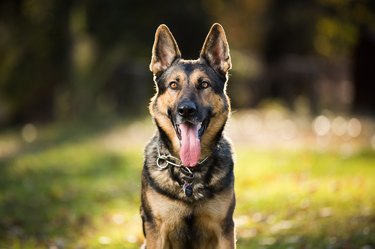
In the words of the old song, "You say tomayto, and I say tomahto." The canine lyrics might read, "You say German shepherd, and I say Alsatian," depending on whether you're from the U.S. or the British Isles. The names refer to the same dog.
No matter what you call this breed, they are considered among the finest of all working dogs. Although technically a member of the herding group, German shepherds excel in all sorts of tasks, whether it concerns military and police work, search and rescue, guiding the blind, obedience, or therapy. They were bred for trainability and loyalty; the qualities still deemed essential in the breed.
Video of the Day
Video of the Day
History of the German Shepherd dog
Why the name change? It all goes back to World War I. The breed was developed in the late 19th century and was known as the Deutscher Schaferhund, which translates into English as German shepherd dog. When the First World War broke out, Allied countries wanted nothing to do with anything containing "German" in its name. Thus, the American Kennel Club changed the name of the German shepherd to "shepherd dog" in 1917, just as the U.S. was about to enter the fray.
In Great Britain and some European countries, the name was changed to Alsatian, after the Alsace-Lorraine region, according to Total German Shepherd. While the name was officially changed back to German shepherd by the breed club in 1977, today many Irish and British people still refer to Alsatians rather than German shepherds.
AKC German shepherd standard
The American Kennel Club standard for the German shepherd calls for a male dog height of 24-to-26 inches and 22-to-24 inches for females. The animal is longer than tall, with an ideal proportion of 10-to-8.5. That does not derive from a long back, but from the overall length-to-height relationship. The head is described as "noble, cleanly chiseled, strong without coarseness, but above all not fine."
Males weigh between 65-and-90 pounds, with females slightly smaller at 50-to-70 pounds. While breed popularity rankings change annually, the German shepherd is generally the second or third most popular dog in the country.
Kennel Club German shepherd standard
It's in Britain that such a dog is still colloquially referred to as the Alsatian, but the Kennel Club registers such animals as German shepherds. The standard is similar to that of the AKC, with an ideal height of 25 inches listed for males and 23 inches for females. The Kennel Club describes the German shepherd temperament as "Steady of nerve, loyal, self-assured, courageous, and tractable. Never nervous, over-aggressive, or shy." Those are the qualities breed founder Max von Stephanitz sought in the late 19th-and-early-20th centuries.
European German shepherd
Pedigree points out that the standards for the American and European German shepherd are somewhat different. The American type is larger than its European cousin, with a more refined head, more bend in the rear legs, and a more angled torso. The European German shepherd's head is larger, with a wider and shorter backline, and straighter hind legs. The European standard focuses on the working dog, which is one reason many law enforcement agencies prefer the European dog for police work.
American Alsatian
There is a breed known as the American Alsatian. However, this relatively recent breed — it was developed in California in the 1980s — was meant to resemble an extinct type of wolf known as the Dire. This rare breed is also known as the North American Shepalute and the Alsatian Shepalute. That's because its foundation lines are German shepherds and Alaskan malamutes, so they are not purebred German shepherds.